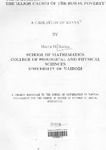| dc.description.abstract | Poverty is a multi-dimensional phenomenon whose causes are complex and difficult to Measure precisely. The need to articulate causes of poverty in developing countries is Paramount given its effects. This study examines the major causes of rural poverty from 942 households. For poverty reduction strategies to be effective, they must be closely linked with the objectives of the poverty alleviation program. Most of the official poverty statistics released including the data statistics used in this study focuses on the poverty incidence, the income gap, and the poverty gap and traps. However, identifying the characteristics of vulnerable families and the vulnerable provinces is important towards understanding the causes of their vulnerability and in formulating programs on poverty reduction. This study proposed a framework and a methodology for identifying the sub locations, districts and the provinces where these families are located and the indicators of a potential deprived community to guide program implemented in the allocation of resources. In this study logistic regression analysis was applied. The results indicated that family size, geographical location, agriculture knowledge, empowerment and the gender of the head of the household as the key determinant of the probability of one being poor in a rural set up. Age is factor when run as a univariate logistic regression but when run in a multivariate logistic regrassion it is not a predictor of ones probability of being poor. | en_US |

